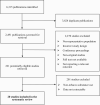Global Patterns and Prevalence of Dual and Poly-Tobacco Use: A Systematic Review
- PMID: 34009377
- PMCID: PMC8825763
- DOI: 10.1093/ntr/ntab084
Global Patterns and Prevalence of Dual and Poly-Tobacco Use: A Systematic Review
Abstract
Introduction: Improving understanding of the epidemiology of dual and poly-tobacco product use is essential for tobacco control policy and practice. The present study aimed to systematically review existing epidemiologic evidence on current dual and poly-tobacco use among adults globally.
Methods: We systematically searched online databases for studies published up to June 30, 2020. We included quantitative studies with measures of nationally representative prevalence of current dual or poly-tobacco use among adults. Prevalence estimates for each country were extracted manually and stratified by WHO regions and World Bank income classifications.
Results: Twenty studies with nationally representative prevalence data on current dual or poly-tobacco use in the adult population across 48 countries were included. Definitions of dual and poly-tobacco use varied widely. Prevalence of dual and poly-tobacco use was higher in low- and lower-middle-income countries compared to other higher-income countries. Current dual use of smoked and smokeless tobacco products among males ranged from 0.2% in Ukraine (2010) and Mexico (2009) to 17.9% in Nepal (2011). Poly-tobacco use among males ranged from 0.8% in Mexico (2009) and 0.9% in Argentina (2010) to 11.4% in the United Kingdom and 11.9% in Denmark in 2012. Dual tobacco use was generally higher in South-East Asia; poly-tobacco use was prevalent in Europe as well as in South-East Asia.
Conclusions: This is the first systematic review of the prevalence estimates of dual and poly-tobacco use among adults globally. The results of the current study could significantly help health policy makers to implement effective tobacco control policies.
Implications: This study demonstrates that dual/poly-tobacco use is common in many countries of the world, and highlights the need for in-depth exploration of this field in future studies, especially in high prevalence regions such as South-East Asian and European countries. In light of this, the global tobacco control community and health authorities should also agree upon a consistent operational definition of dual and poly-tobacco use to propel research and improve surveillance of dual/poly-use in health surveys for better communication and understanding of these phenomena.
© Crown copyright 2021.
Figures
Similar articles
-
Prevalence and Sociodemographic Determinants of Any Tobacco Use and Dual Use in Six Countries of the WHO South-East Asia Region: Findings From the Demographic and Health Surveys.Nicotine Tob Res. 2016 May;18(5):750-6. doi: 10.1093/ntr/ntv286. Epub 2016 Jan 4. Nicotine Tob Res. 2016. PMID: 26729735
-
Prevalence and determinants of dual and poly-tobacco use among males in 19 low-and middle-income countries: Implications for a comprehensive tobacco control regulation.Prev Med. 2021 Jan;142:106377. doi: 10.1016/j.ypmed.2020.106377. Epub 2020 Dec 17. Prev Med. 2021. PMID: 33346037
-
Poly-tobacco use among adults in 44 countries during 2008-2012: evidence for an integrative and comprehensive approach in tobacco control.Drug Alcohol Depend. 2014 Jun 1;139:60-70. doi: 10.1016/j.drugalcdep.2014.03.003. Epub 2014 Mar 15. Drug Alcohol Depend. 2014. PMID: 24685560
-
The global impact of tobacco control policies on smokeless tobacco use: a systematic review.Lancet Glob Health. 2023 Jun;11(6):e953-e968. doi: 10.1016/S2214-109X(23)00205-X. Lancet Glob Health. 2023. PMID: 37202029
-
Association of Smokeless Tobacco Use and Oral Cancer: A Systematic Global Review and Meta-Analysis.Nicotine Tob Res. 2019 Aug 19;21(9):1162-1171. doi: 10.1093/ntr/nty074. Nicotine Tob Res. 2019. PMID: 29790998
Cited by
-
Estimating the Prevalence of and Clarifying Factors Associated With Multiple Tobacco Product Use in Japan: A Cross-sectional Study in 2022.J Epidemiol. 2025 May 5;35(5):222-229. doi: 10.2188/jea.JE20240153. Epub 2025 Mar 31. J Epidemiol. 2025. PMID: 39462542 Free PMC article.
-
Trends in the use and dual use of factory-made combustible cigarettes, other tobacco products and electronic cigarettes: Results from South African Social Attitudes Surveys during 2007 to 2018.Tob Induc Dis. 2023 Jul 17;21:94. doi: 10.18332/tid/168121. eCollection 2023. Tob Induc Dis. 2023. PMID: 37465256 Free PMC article.
-
Sex and Sexual Identity Differences in Poly-tobacco Use and Psychological Distress in U.S. Adults: Results From the National Health Interview Survey.Nicotine Tob Res. 2023 Jan 1;25(1):19-27. doi: 10.1093/ntr/ntac180. Nicotine Tob Res. 2023. PMID: 35894290 Free PMC article.
-
Patterns and Correlates of Multiple tobacco Product use Among people With HIV in India.Tob Use Insights. 2024 Dec 9;17:1179173X241303587. doi: 10.1177/1179173X241303587. eCollection 2024. Tob Use Insights. 2024. PMID: 39659298 Free PMC article.
-
Associations between vaping and daily cigarette consumption among individuals with psychological distress.Tob Prev Cessat. 2024 Jun 20;10. doi: 10.18332/tpc/189769. eCollection 2024. Tob Prev Cessat. 2024. PMID: 38903697 Free PMC article.
References
-
- Ng M, Freeman MK, Fleming TD, et al. Smoking prevalence and cigarette consumption in 187 countries, 1980-2012. JAMA. 2014;311(2):183–192. - PubMed
-
- Lee YO, Hebert CJ, Nonnemaker JM, Kim AE. Multiple tobacco product use among adults in the United States: cigarettes, cigars, electronic cigarettes, hookah, smokeless tobacco, and snus. Prev Med. 2014;62:14–19. - PubMed
-
- Goodwin RD, Wall MM, Gbedemah M, et al. Trends in cigarette consumption and time to first cigarette on awakening from 2002 to 2015 in the USA: new insights into the ongoing tobacco epidemic. Tob Control. 2018;27(4):379–384. - PubMed
-
- Sinha DN, Suliankatchi RA, Amarchand R, Krishnan A. Prevalence and sociodemographic determinants of any tobacco use and dual use in six countries of the WHO South-East Asia Region: findings from the demographic and health surveys. Nicotine Tob Res. 2016;18(5):750–756. - PubMed
Publication types
MeSH terms
LinkOut - more resources
Full Text Sources
Other Literature Sources
Medical


